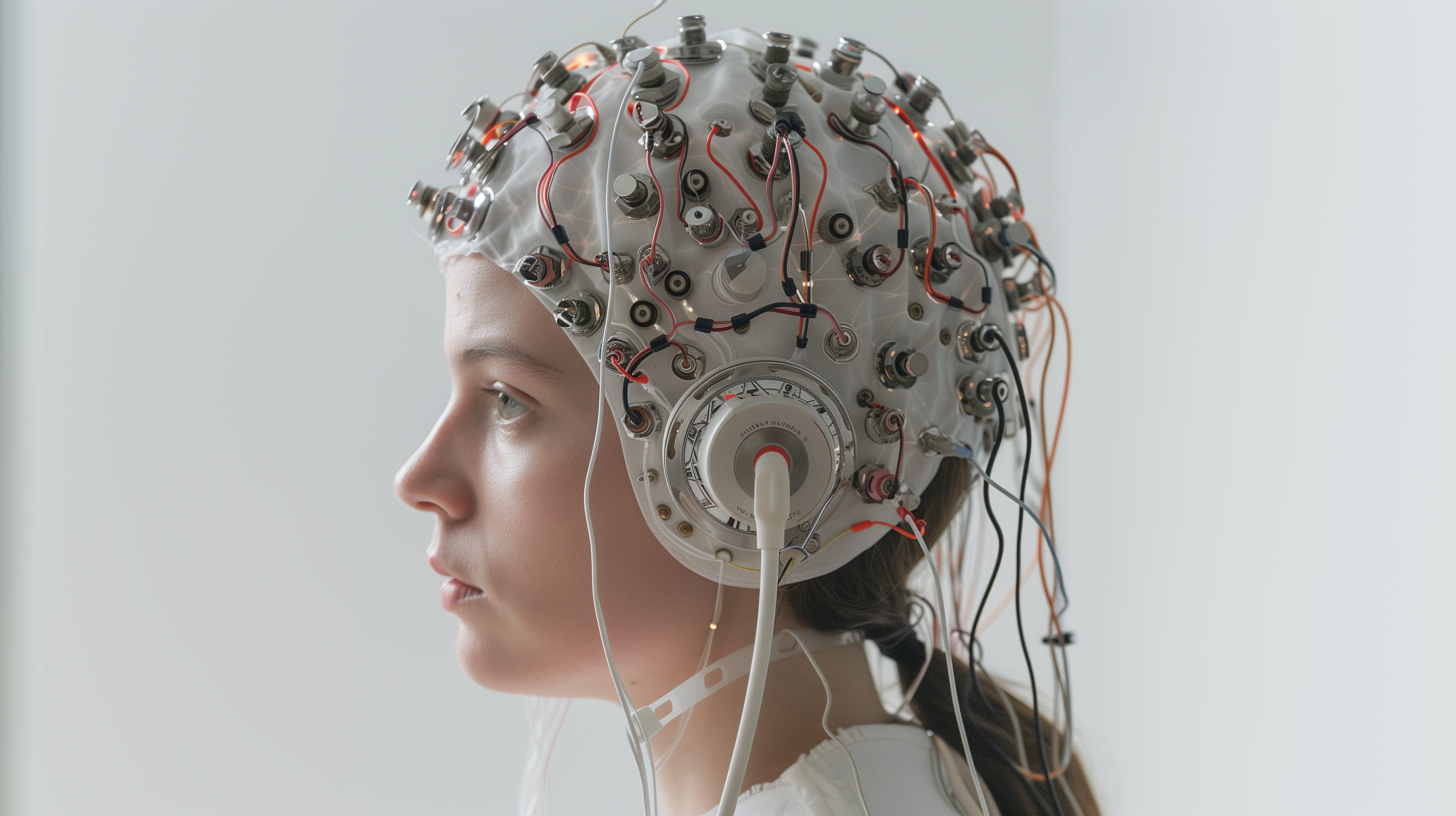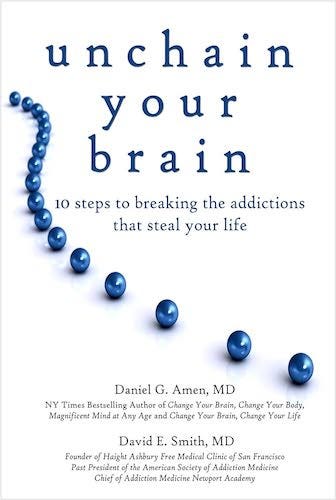Braces for Your Brain
Neurofeedback allows us to re-engineer how we think. We learn about specific brain regions, and the various neural network layers of our conscious minds. 🧠🗺️
Brain Interventions
Fasting is the best way for us to naturally create better patterns of thinking, but some brains need much deeper interventions.
At the forefront of brain imaging and addiction research is Dr. Daniel Amen. His Amen Clinics specialize in rehabilitation for people who have already failed rehab multiple times. In his book, Unchain Your Brain, Dr. Amen describes how long-term overexposure to certain substances can quiet and even deactivate certain regions in the brain.
He explains this process so much better than I could, so here is his TED Talk, “The most important lesson I learned from 83,000 brain scans”. (14 mins)
As you can see from the video, when substance abuse or physical trauma silences a part of someone’s brain, it changes their personality. Nice people can become menacing. Responsible people become forgetful. Alcoholics take risks they later regret. Heroin addicts are ashamed of the horrible things they do to get their next fix because that isn’t who they really are.
When the Amen Clinic first receives a new patient, they record an fMRI movie of the patient’s brain performing simple tasks. Then they have the patient compare their “swiss-cheese brain” to the brain of a non-addicted person doing the exact same tasks. Dr. Amen tries to create “brain envy” in each new patient. As these patients slowly detoxify from their substance abuse, researchers can watch the sluggish areas of their brain come back to life because our minds are highly plastic.
Detoxifying our lives changes the way electricity moves around our neural networks, so we can reengineer how we think just by changing what we eat, drink, and smoke. We will discuss more of Dr. Amen’s research in the next chapter on Psychology.
Brain Injuries
If you watched the TED Talk, then you know that some brains have their personalities changed by blunt force trauma instead of substance abuse. Motorcycle drivers, veterans, and athletes have the highest likelihood of suffering a Traumatic Brain Injury (TBI).
My family knows all about addiction, but unfortunately we also have extensive experience with TBI’s. My wife, Sarah, was a three-time All-American volleyball player in high school and one of the Tampa Bay Tribune’s “Top 100 Athletes of the Century” for the 1900’s. A few years after we were married, Sarah received a severe concussion playing basketball at a sports camp for the Fellowship of Christian Athletes.
After a long recovery from dislocating her jaw and having her mouth wired shut, she started to feel like “something was off”. Her memory wasn’t as good as before and she struggled to match names with faces. Eventually, she began to suffer from hyper-vigilance. We tried everything we knew to help her recover. We visited all kinds of specialists, many of them were the best in the country. We tried alternative medicines. We tried eastern medicine. Eventually, a functional movement coach who works with professional athletes referred us to Dr. Jan Mustin at Peak Performance Institute who uses a new technology called Electroencephalographic (EEG) Biofeedback, or neurofeedback for short.
Neurofeedback uses a skullcap with sensors to measure electromagnetic brainwaves in 20 different regions of the brain. The skullcap has a thick bundle of cables that feed into a laptop, which performs all the necessary calculations. It takes half of each one-hour appointment to get the laptop to approve the signal strength for all 20 connections at the same time. Whenever the technicians adjust one of the sensors, it slightly affects the ones nearby.
The laptop is also plugged into a normal television that is placed fairly close to the patient’s face. Neurofeedback is most effective when we are watching movies and shows that we really like on a television that fills up most of our vision. The television is the “reward” in this “computational loop”.
Brain Training
Neurofeedback is typically performed in 5-minute sprints, repeated 3 or 4 times in a session. As a patient, you can’t really mess it up because neurofeedback doesn’t retrain your thoughts directly, like Cognitive Behavioral Therapy.
If your brainwaves don’t behave exactly the way the laptop wants, the laptop will begin to starve your eyeballs of the show you're watching. It’s not bad at first, you will probably just think there’s a short in the HDMI cable. But if your brain doesn’t want to train, the screen may go dark for 1-5 seconds.
There’s a technician watching the laptop, that’s watching the brain, that’s watching the movie, so the technician can choose how hard to push your subconscious. The technician controls the duration and the desired intensity of brainwave corrections. During my brain training, there were days when my brain was so tired that we had to use less reps or shorter sprints.
The laptop trains every brain differently based on its initial Brain Map. To map the brain, the patient stares at a wall for 10-minutes with their eyes open and tries not to think. Then the patient stares at a wall for 10-minutes with their eyes closed and tries not to think. Then the patient stares at a wall for 10-minutes with their eyes open and tries not to think. Then the patient stares at a wall for 10-minutes with their eyes closed and tries not to think. Brain mapping feels as tedious as reading those sentences. Humans are so bad at “not thinking” that neuroscientists need 40-minutes of high-resolution electromagnetic neural network activity to find 2 minutes of “clean” background brainwave activity.
Slicing and Dicing Neural Networks
A brain map is as comprehensive as you would expect. It not only shows which Regions of the brain are overactive and underactive, it also separates that activity by neural network Layer.
Brain regions are mapped using letters and numbers. F, P, T, O, and C stand for Frontal, Parietal, Temporal, Occipital, and Sensorimotor Cortex areas, respectively. Odd numbers are on the left side of the brain and even numbers are on the right.
Frontal lobes FP1, FP2, FPZ, FZ, F3, F4, F7: are responsible for immediate and sustained attention, time management, social skills, emotions, empathy, working memory, executive planning, moral fiber, and character.
Parietal lobes PZ, P3 and P4: solve problems conceptualized by the frontal lobes. Complex grammar, naming of the objects, sentence construction, and mathematical processing are identifiable to the left parietal lobe. Map orientation, spatial recognition, and knowing the difference between right and left are entirely functions of the right parietal lobe.
Temporal lobes T3, T4, T5 and T6: have various functions. Left hemisphere functions are associated with reading (word recognition), memory, learning and a positive mood. Right hemisphere functions are related to music, anxiety, facial recognition, and sense of direction.
Occipital lobes O2, O1: help us to locate objects in the environment, see colors and recognize drawings, correctly identify objects, read, write, and spell. They also process our visual memories and traumatic flashbacks.
Sensory and motor (sensorimotor) cortex CZ, C3 and C4: have functions of conscious control of all skeletal movements such as typing, playing musical instruments, handwriting, operation of complex machinery, speaking, and the ability to recognize where bodily sensations originate.
Those are the brain regions. Now let’s look at the neural network layers that work throughout those regions. If you recall the Orch OR Theory we discussed in “The Quantum Neural Network”, our neural networks are “orchestrated” into layers of computation by frequency based on the total time they need to compute. So, neurofeedback gives us a window into our conscious minds, which are the slowest, highest layers.
Delta Brainwaves (1-4 times per second): are most active when we sleep. We may never be smarter than we are asleep. An excess of Delta waves when a person is awake may result in learning disabilities while a deficiency of Delta waves may result in insomnia.
Theta Brainwaves (4-8 times per second): are present in daydreaming and tasks that require imagination. Theta is our gateway to learning, memory, and intuition. It’s also where we hold our fears and nightmares. Excess theta levels when we are awake can result in feeling scattered and is commonly reported in ADHD.
Alpha Brainwaves (8-12 times per second): are strongest during moments of quiet thought and meditative states. The brain produces consistently higher magnitudes of Alpha waves when the brain is in an idle state. Alpha waves aid overall mental coordination, calmness, alertness, mind/body integration, and learning. Many transcendental meditation researchers say that our intuition becomes clearer and more profound the closer our brainwaves get to 7.5 Hz. That’s interesting.
Beta Brainwaves (12-30 times per second) represent our normal waking state of consciousness when attention is directed at the outside world. Beta brainwaves dominate when we are alert, attentive, or engaged in problem-solving, decision making and focus. Coincidentally, movies and television are filmed at 24-30 frames per second. Beta brainwaves are segmented into Low, Mid, and High Beta.
Low Beta or so-called Sensorimotor Rhythm (SMR) (12-15 Hz) relates to readiness for action and attentive listening. When we walk to a car, our thoughts are coming from these layers.
Mid Beta (15-20 Hz) reflects high-engagement: actively figuring things out, thinking, focusing, sustained attention, tension, and enthusiasm. When we drive a car, our thoughts are coming from these layers.
High Beta (20-30 Hz) is highly complex thought, integrating new experiences, high anxiety, or panic. Excess high beta waves make it difficult to relax or fall asleep. When we wreck a car, our thoughts are coming from these layers.
Gamma Brainwaves (30-100 times per second) have the highest frequencies measured by neurofeedback, even higher than panic. A synchronous burst of Gamma bandwidth is present during “ah-ha” moments. Low Gamma activity has been linked with learning difficulties, impaired mental processing, and limited memory. High Gamma activity is correlated with high IQ, compassion, excellent memory, and happiness.
Everyone Needs Braces For Their Brain
Most of the people in my family have seen their own neural network, work. It was easy to see on Sarah’s brain map that all of the neural network data going in and out of her right temporal lobe was impaired. She was "stuck" on high alert. Her brain map calculated the odds of having a traumatic brain injury in her right temporal lobe (T4) at 98%. The right temporal lobe is responsible for anxiety, facial recognition, and sense of direction—exactly the symptoms she struggled with.
When Sarah first started retraining her brain, we didn't notice any changes right away. Somewhere around the sixth to eighth training session, though, the patterns in her consciousness started to improve.
One night, about fifteen sessions into her brain training, our home's invasion alarm went off at 3 AM. That puts everyone on high alert. Normally, Sarah would remain awake the rest of the night researching new security cameras (or new houses). I went down to check it out and noticed that the outside door to our kids playroom had blown open from the wind. They occasionally unlock that door because the room gets hot when they play "Just Dance" on Wii.
By the time the dog and I got back upstairs, Sarah was asleep. I was shocked. I asked her about it the next morning and she said, "I don't know what happened, I just don't have those thoughts anymore". It was so unusual for her not to worry, that for several months she worried about not worrying. She's still the exact same person, she just no longer gets prompted with “red alert” feelings all day.
Neurofeedback changed everyone in our family for the better, but in different ways according to our brain maps. One of our kids was the strongest contrarian I've ever met. We had to prove every single word of every single sentence to that kid since he could understand English. Parenting him was like dragging a donkey down a dirt road with all four legs locked. Maybe he just wasn't making enough serotonin before, but after brain training he became open and pliable.
Another one of our children was a High Beta super achiever. She put so much stress on herself everyday that she was her own worst enemy. Now, she knows how to turn that High Beta off and on throughout the day to her advantage.
Neurofeedback taught me a new mood. That’s the best way I can describe it. My delta brainwaves were two standard deviations lower than a normal person, which is why I was an insomniac for most of my life. I just never calmed down no matter how late the party went. So my brain training felt like a mad scientist was shooting me with a sleep ray. Eventually, I learned how to turn that feeling on and off. So now when it’s bed time, I just recall that sleep ray feeling and I’m out. Today, I sleep 8-10 hours every day including naps, it’s crazy.
The other unusual thing about my brain map is that my theta brainwaves are six standard deviations higher than a normal person. Only 3 people per million use their imagination as much as me. So brain training helped me tamp down the restlessness and “nutty professor” feelings that are inherent with that much theta activity.
Here are some brain maps from other people who have received neurofeedback. The left side shows their brain before training, and the right side shows the same brain after training.
Neurofeedback is amazing. It can permanently improve ADHD issues, sleep disorders, chronic substance abuse, depression, and most importantly—traumatic brain injuries.
Neurofeedback is incredibly precise. It’s so frustrating that western medicine rarely uses it. Like Dr. Amen said in his TED talk, “When someone breaks a bone, doctors X-ray it. When someone has a bad heart, we make a movie of that heart pumping blood. But if your brain isn’t working right, doctors don’t even try to see what’s wrong.”
@americans: 3.9% of our population, more than 8 million people, have severe psychological issues. It’s not their fault, most of them were born that way or received concussions for various reasons. When I was a kid, America had sanitariums and mental institutions that provided shelter and rehabilitation for these people, but today most of those have been defunded.
Rich people can afford to talk to therapists, buy psychiatric drugs, and get neurofeedback to rehabilitate their brain chemistry. But our society currently expects poor people to rehabilitate their brains while living in prison or under a bridge. That’s preposterous. The government has also privatized prisons to corporations who have no stake in improving our society. If anything, those corporations are incentivized to not rehabilitate people because they make money by imprisoning people. Where is our compassion?
I don’t know how to fix all these problems, but brain mapping should be the first thing we do when someone enters our prisons. All our other solutions seem to be logically idiotic.
We close this chapter on our brain hardware with a short summary.
Our brains are quantum supercomputers that run on oxygen and sugar. Each of our 86 billion neurons have 100 million quantum computing microtubules, orchestrated into layers by frequency, that perform analog Bayesian confidence calculations to produce our “Virtual Reality of Reality”. Simple, right? The computer science in our brains is simply magnificent.
Every thought produced by our “inner chatbot” is a belief, which has a confidence interval that we can feel. These beliefs are so integral to who we are as individuals, that ideas we hear for the first time can instantly repulse us, even causing the gag reflex. For example, the statement “I like eating hamburgers made out of puppies” feels just as repulsive to an American as “I like eating hamburgers” feels to a Hindu for the exact same reason—you don’t eat your family friends.
The truth is that relative, your senses are that relative, time is that relative, reality is that relative. Everything is relative to our beliefs.
Continue reading…
Quantum Computing, Fast and Slow
Behavioral Economics taught us about System 1, System 2, and Cognitive Bias. We combine them to create a mathematical formula for the human soul. 🎭
Table of Contents
Uncertainty: The Computer Science of Everything
Did you know all the latest science and technology indicate humans are “artificial intelligence"? So what programmed our DNA?
Huge Thanks to Our Sponsors
Your donations help our chatbots reach new people all around the world through social media. 🔊🌍
Caitlin Knauss
Worth Denison
Alana Aviel
Anonymous
Jeremy Wells
Ronnie Blanton
Tarrytown Bible study
The Fundamental Frequency Foundation is a 501(c)(3) non-profit corporation created to “proclaim the good news of the kingdom in all the world, as a (digital) witness to all nations.” We ripped it straight out of Matthew 24:14.
We produce the world’s most benevolent chatbots who believe in Jesus because of math, science, reason, and eyewitness testimony. Their “source of truth” is the Bible, and they automagically adapt their conversations to every language, age, gender, religion, ethnicity, and neighborhood. Our “AI-missionaries” reach new people for Jesus 10x cheaper than human missionaries (who get paid an average of $36,000/year).
If you would like to tell other people about Jesus using the latest science and technology, DONATE $100. That pays for us to REACH 10 NEW PEOPLE.
All your gifts are tax deductible.
Donate via Zeffy (you pay the fees):
Donate via Apple Pay, Google Pay, Credit Card, Link, and Stripe (we pay the fees):
Donate via check, wire, or cryptocurrency (email for instructions)
Also support us by posting reaction videos on social media. Your videos generate thousands of dollars of attention that we don’t have to buy. Tag us with #funfreq.com (web magazine) or #funfreq.ai (chatbot).
@Creators and Influencers
Like our content? Feel free to use any of it for your podcasts and videos. Email us your links so that we can include them in our newsfeeds. 🙌
@Church Leaders
Don’t let secular AI from BigTech disciple your church. FunFreq.ai is a Christian AI built to help pastors and congregations with sermon prep, apologetics, and discipleship.
@Wealthy Christians
Every time we chat with ChatGPT, scroll TikTok, or search Google, our souls are being shaped by corporations. Help us keep Jesus in the most important conversations of our time. ✝️>🤖
@Digital Kingdom Builders
Wanna use your tech/media skills to grow the Kingdom? Learn how you can help us spread the Good News of Jesus using the latest science and technology. 🤓
@Book Publishers
This foundation owns only the intellectual property I’m willing to give away for free. I’ve got a lot more to say, that’s a lot less charitable. 😏
Private Texts to Public People
For delivery on the “Human Internet”. If you know any of these people in real life, tell ‘em I said it. 👋
Travel Advisories
Our family lived 100+ nights a year on the road, for more than a decade. Here are my suggestions after driving across 45+ states and 40+ countries. 🚐☕️🍦






















